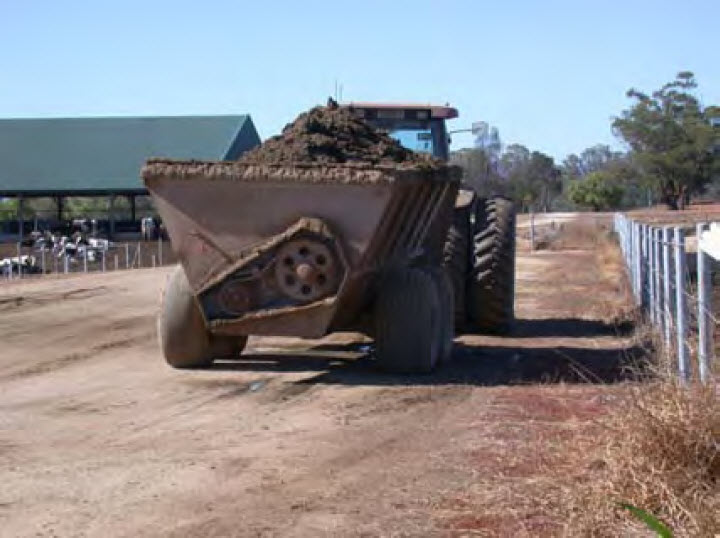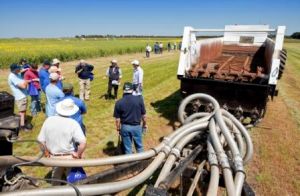- There is growing farmer interest in using alternative nutrient sources such as natural or organic fertilisers and soil conditioners instead of traditional manufactured fertiliser to improve productivity and soil health
- Organic fertilisers provide nutrients to promote plant growth (fertiliser), whilst also improving the physical and biological composition of the soil (conditions the soil)
- Inorganic fertilisers generally do not have the ability to condition the soil
- Nutrients in organic fertilisers are available more slowly, over a longer period, than those in most manufactured fertilisers. This may be a disadvantage when plants have an immediate need for nutrients, but it can be an advantage under high leaching conditions, in that nutrient loss from the soil is reduced
|
- The benefits of improved soil health using these natural alternative sources are widely accepted, however there are numerous questions around whether the products being sold to improve soil health actually change soil biological activity and ultimately are cost effective in maintaining or increasing production
- Uncomposted animal manures have a higher proportion of immediately available nutrients than composted materials. Consequently, the plant production benefits of compost may not be as be apparent until several years after application
|
Understanding the question
|
| Why are organic fertilisers important to me as a farmer?
|
- Current farming systems largely rely on energy-intensive inorganic fertilisers to supply
nutrients, due to ease of application and ability to time applications in response to plant
demand
- Increasingly, organic wastes and manures are being considered as a lower cost, more
environmentally friendly source of nutrients
|
- The reasons behind wanting to explore these alternatives is understandable:
- Increases in traditional fertiliser prices in the mid 2000's
- Concerns about the long term supply of rock phosphate to meet future demand
and the realisation that some of the phosphorus applied in traditional fertiliser is
'locked up' by the soil and not available for plant growth
|
| What are they and how do they work?
|
Fertiliser definition:
- A fertiliser or soil conditioner is any material added to the soil or applied to a plant to
improve the supply of nutrients and promote plant growth. This definition includes both
inorganic and organic fertilisers and soil conditioners, such as lime and gypsum, which
may promote plant growth by increasing the availability of nutrients that are already in
the soil or by changing the soil'sphysical structure
- Soil conditioners are materials that make the soil more suitable for the growth of plants
- Most organic amendments function as a fertiliser and soil conditioner
- Inorganic fertilisers
- Sometimes called commercial or artificial fertilisers - mostly contain chemicals with the essential plant nutrients in available forms, the production of which involves some industrial process. Examples include urea, superphosphate and muriate of potash. These do not have an ability to condition the soil
- Organic fertilisers
- Often referred to as natural fertilisers, natural soil conditioners. or recycled organics
- Are made up of organic material containing carbon from animal and plant products. These materials are usually generated from intensive livestock operations and municipal authorities
- Examples include blood and bone, compost, chicken manure, dairy factory
effluent and fishmeal products
|
- They tend to be slower releasing (in other words, it takes time for the nutrients to
become available in the soil for plants) and to contain fewer nutrients per
kilogram than the inorganic fertilisers
- They supply varying quantities of nitrogen, phosphorus, potassium and sulphur,
as well as some trace elements; and their composition can be quite variable.
- They also contribute a small amount of organic matter to the soil, which improves the soil structure and sustains biological activity for the maintenance of long term soil fertility

Figure 1 : Organic fertiliser - Source: Soil Knowledge Bank
|
| How effective are organic fertilisers?
|
General
- Some potential benefits of organic fertilisers are:
- There is a reduced likelihood of 'burn' damage to salt sensitive plants and seedlings due to the slower release of nutrients
- They can supply trace or minor nutrients, although some manufactured fertilisers also supply these
- Their organic matter content can help improve soil biology and structure and increase water and nutrient retention for plants, especially in sandy soils, although large quantities are required to have much long-term effect
- They generally have lower levels of heavy metal contaminants than manufactured fertilisers, although some organic fertilisers contain appreciable amounts
- They can be used to improve degraded areas and improve their soil health
- A good compromise that is becoming increasingly popular with farmers is to use a combination of manufactured and organic fertilisers, to gain the benefits offered by both types. For example, an application of organic fertiliser such as poultry manure can be supplemented later with dressings of manufactured nitrogen (N) fertiliser. This not only provides some nitrogen (N) in a quick release form, but also means that lower rates of organic fertiliser can be used
Organic wastes (uncomposted animal manures)
- Approximately 25% of organic waste originates from agricultural industries, with the main production in feedlots and intensive animal industries such as poultry
- Local sourcing of wastes will improve the economics of their use on-farm due to lower freight costs - a significant component of total costs in using organic residues
|
- A range of potential benefits can be gained from the use of recycled organic nutrients including:
- Potential to sequester carbon and decrease greenhouse gas emissions when incorporated into soil
- Lower input costs (approximately half the cost of inorganic fertilisers for the equivalent nutrient value)
- Sustained release of nutrients and increased reserve of organic nitrogen (N)
- Bulk poultry litter can be the basis of very productive and valuable pasture and agricultural production when used wisely
- Immediate supply of nutrients. As most manure contains nitrogen (as ammonium), phosphorus, potassium, and micronutrients that can be used directly by plants, this is the most commonly recognized value of manure in the south west region, especially in cropping situations
- Delayed supply of nutrients. Other nutrients in manures are part of the organic (carbon-containing) compounds. These compounds trigger biological activity which makes nutrients in the manure and other organic matter available to plants

Figure 2 - Screed solids from feedlot dairy wastewater being transported for
application to an adjacent field. - Source: DPI, NSW
|
Organic wastes (composted manures and recycled organics)
- Composting is the biological decomposition of organic materials by microorganisms under controlled, aerobic conditions to a relatively stable humus-like material called compost
- Composting can happen in many different ways using a variety of materials, methods, equipment, and scales of operation
- For agricultural operations the common materials or feedstocks that are composted are livestock manures and bedding and various residual plant materials (straw, culls, on-farm processing wastes, etc)
- Compost is a valuable source of organic matter for soils and contains nutrients that are slowly available for plant growth
- Like every production process, the quality of your compost largely depends on the quality of the organic materials that you start with
- If it is done properly, the high temperatures of the composting process can sterilise weed seeds and pathogens that may be present in the raw organic materials
- On-farm based composting can be done relatively cheaply if the right equipment is available
- Compared with fresh animal manures, mature composts have a lower proportion of nutrients immediately available to plants. Consequently, benefits may not be apparent until several years after application
Other organic fertilisers:
Biochars
Biochar is a stable, carbon-rich form of charcoal that can be applied to agricultural land as part of agronomic or environmental management. It can be produced by pyrolysis; where biomass such as crop stubble, wood chips, manure and municipal waste is heated with little or no oxygen
- There are significant potential productivity and other benefits from adding appropriate biochars to Australian agricultural soils. These include improvements in physical and chemical soil characteristics, nutrient use efficiency and reductions in greenhouse gas emissions derived from nitrogenous fertilisers
- Generally, biochar has been found to improve infertile and degraded soils. However, not all crops behave the same way and not all soils show broad improvements with biochar application; even when the biochar appears fit for purpose
- Within farming systems, biochar may also bind and reduce the efficacy of some agricultural chemicals
- Current knowledge about the effects of adding biochar to Australian agricultural soils is not sufficient to support recommending its use
- Despite the uncertainty surrounding its production and use, some farmers are producing their own biochar
- More research is needed before confident predictions can be made about biochar'ssuitability for use in Australian agricultural systems
|
Biosolids
- Biosolids products that are rich in nutrients can be beneficially used as a soil conditioner for land application. Landholders often seek alternatives to conventional fertiliser and want a product that offers a competitive price and value for money
- Biosolids offer landholders high levels of organic matter, as well as nitrogen (N), phosphorous (P) and other nutrients essential for plant and crop growth
- Biosolids also contribute to soil properties such as structure, moisture retention, moisture content and cation exchange capacity. The nutrients in biosolids are slow release with 15-25% of the N and P becoming available in the first year and the remainder over subsequent years
- Research has shown that biosolids used according to NSW Guidelines can help to improve soil quality and subsequent crop yields over time
- Biosolids can also contain low levels of heavy metals and pathogens. It is important that these meet the requirements set out in current NSW Guidelines
- Prior to any land application an environmental impact assessment is necessary to assess its suitability for biosolids application

Figure 3 - This commercial machine, recently developed by the Geelong Director of
SFS John Sheehan, is capable of manuring one hectare of land in one fill and has six
rippers which cover a width of six metres. - Source: DEPI, Victoria
|
Other related questions in the Brown Book
|
|
Brown Book content has been based on published information listed in the Resources and References sections below
|
- Introducing Fertilisers. Department of Primary Industries, Victoria.
- Jenkin A.Managing soil amendments and fertilisers for a cleaner environment. Agfact
AC.29, October 2004 - Department of Primary Industries, NSW.
- Using recycled organics and manures in grain cropping systems. Department of Primary
Industries, NSW.
- Evaluating alternative fertilisers and biological products for pastures and crops. Result of
the 2009 and 2010 seasons. Woady Yaloak Catchment Group.
- Better Use of Effluent & Fertilisers in Dryland Dairy Farms, Future Ready Dairy Systems Project Case Study. Dairy Australia.
|
- Recycled Nutrients. Soil Health Knowledge Bank - Department of Agriculture, Fisheries
and Forestry.
- Compost. Department of Primary Industries, Victoria.
- Sparkes, J & Stoutjesdijki. Biochar: implications for agricultural productivity. (2011) -
Australian Bureau of Agricultural and Resource Economics and Sciences.
- Use of biosolids in agriculture. Department of Primary Industries, NSW.
- Sale P, Gill J, Peries R and Tang C. Treating hostile subsoils. - (2011) - GRDC.
- Best practice guidelines for using poultry litter on pastures. - Department of Primary
Industries, NSW.
|
|